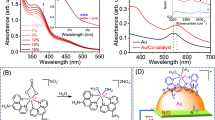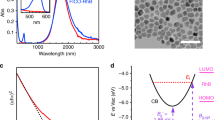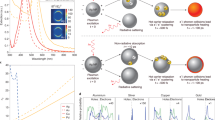Abstract
Strong coupling between plasmons and optical modes, such as waveguide or resonator modes, gives rise to a splitting in the plasmon absorption band. As a result, two new hybrid modes are formed that exhibit near-field enhancement effects. These hybrid modes have been exploited to improve light absorption in a number of systems. Here we show that this modal strong coupling between a Fabry–Pérot nanocavity mode and a localized surface plasmon resonance (LSPR) facilitates water splitting reactions. We use a gold nanoparticle (Au-NP)/TiO2/Au-film structure as a photoanode. This structure exhibits modal strong coupling between the Fabry–Pérot nanocavity modes of the TiO2 thin film/Au film and LSPR of the Au NPs. Electronic excitation of the Au NPs is promoted by the optical hybrid modes across a broad range of wavelengths, followed by a hot electron transfer to TiO2. A key feature of our structure is that the Au NPs are partially inlaid in the TiO2 layer, which results in an enhancement of the coupling strength and water-oxidation efficiency. We observe an 11-fold increase in the incident photon-to-current conversion efficiency with respect to a photoanode structure with no Au film. Also, the internal quantum efficiency is enhanced 1.5 times under a strong coupling over that under uncoupled conditions.
This is a preview of subscription content, access via your institution
Access options
Access Nature and 54 other Nature Portfolio journals
Get Nature+, our best-value online-access subscription
$29.99 / 30 days
cancel any time
Subscribe to this journal
Receive 12 print issues and online access
$259.00 per year
only $21.58 per issue
Buy this article
- Purchase on Springer Link
- Instant access to full article PDF
Prices may be subject to local taxes which are calculated during checkout





Similar content being viewed by others
References
Linic, S., Christopher, P. & Ingram, D. B. Plasmonic-metal nanostructures for efficient conversion of solar to chemical energy. Nat. Mater. 10, 911–921 (2011).
Mubeen, S. et al. An autonomous photosynthetic device in which all charge carriers derive from surface plasmons. Nat. Nanotech. 8, 247–251 (2013).
Oshikiri, T., Ueno, K. & Misawa, H. Plasmon-induced ammonia synthesis through nitrogen photofixation with visible light irradiation. Angew. Chem. Int. Ed. 53, 9802–9805 (2014).
Clavero, C. Plasmon-induced hot-electron generation at nanoparticle/metal-oxide interfaces for photovoltaic and photocatalytic devices. Nat. Photon. 8, 95–103 (2014).
Brongersma, M. L., Halas, N. J. & Nordlander, P. Plasmon-induced hot carrier science and technology. Nat. Nanotech. 10, 25–34 (2015).
Takakura, R. et al. Water splitting using a three-dimensional plasmonic photoanode with titanium dioxide nano-tunnels. Green Chem. 19, 2398–2405 (2017).
Zhang, Z., Zhang, L., Hedhili, M. N., Zhang, H. & Wang, P. Plasmonic gold nanocrystals coupled with photonic crystal seamlessly on TiO2 nanotube photoelectrodes for efficient visible light photoelectrochemical water splitting. Nano Lett. 13, 14–20 (2012).
Lu, Y. et al. Gap-plasmon based broadband absorbers for enhanced hot-electron and photocurrent generation. Sci. Rep. 6, 30650 (2016).
Ng, C. et al. Hot carrier extraction with plasmonic broadband absorbers. ACS Nano 10, 4704–4711 (2016).
Hedayati, M. K. et al. Design of a perfect black absorber at visible frequencies using plasmonic metamaterials. Adv. Mater. 23, 5410–5414 (2011).
Christ, A., Tikhodeev, S. G., Gippius, N. A., Kuhl, J. & Giessen, H. Waveguide-plasmon polaritons: strong coupling of photonic and electronic resonances in a metallic photonic crystal slab. Phys. Rev. Lett. 91, 183901 (2003).
Pei, D. et al. Dual-band perfect absorption and field enhancement by interaction between localized and propagating surface plasmons in optical metamaterials. J. Opt. 13, 075005 (2011).
Zeng, P. et al. Photoinduced electron transfer in the strong coupling regime: waveguide-plasmon polaritons. Nano Lett. 16, 2651–2656 (2016).
Hägglund, C. et al. Strong coupling of plasmon and nanocavity modes for dual-band, near-perfect absorbers and ultrathin photovoltaics. ACS Photon. 3, 456–463 (2016).
Lipson, S. G., Lipson, H. & Tannhauser, D. S. Optical Physics 3rd edn (Cambridge Univ. Press, Cambridge, 1995).
Nishijima, Y., Ueno, K., Yokota, Y., Murakoshi, K. & Misawa, H. Plasmon-assisted photocurrent generation from visible to near-infrared wavelength using a Au-nanorods/TiO2 electrode. J. Phys. Chem. Lett. 1, 2031–2036 (2010).
Zhong, Y. et al. Plasmon-assisted water splitting using two sides of the same SrTiO3 single-crystal substrate: conversion of visible light to chemical energy. Angew. Chem. Int. Ed. 53, 1–6 (2014).
Tian, Y. & Tatsuma, T. Mechanisms and applications of plasmon-induced charge separation at TiO2 films loaded with gold nanoparticles. J. Am. Chem. Soc. 127, 7632–7637 (2005).
Hutchison, J. A., Schwartz, T., Genet, C., Devaux, E. & Ebbesen, T. W. Modifying chemical landscapes by coupling to vacuum fields. Angew. Chem. Int. Ed. 51, 1592–1596 (2012).
Sheldon, M. T., van de Groep, J., Brown, A. M., Polman, A. & Atwater, H. A. Plasmoelectric potentials in metal nanostructures. Science 346, 828–831 (2014).
Acknowledgements
We are grateful to T. W. Ebbesen for fruitful discussions about the strong coupling between the nanocavity and LSPR. We also acknowledge financial support from JSPS KAKENHI (grant no. JP18H05205, JP17H01041, JP17H05245, JP17H05459, JP16H06506 and JP15K04589), the Nanotechnology Platform (Hokkaido University), and the Dynamic Alliance for Open Innovation Bridging Human, Environment and Materials (Five-Star Alliance) of MEXT.
Author information
Authors and Affiliations
Contributions
H.M. supervised the project. X.S. performed all the experiments. X.S. and K.U. wrote the manuscript. T.O. provided technical support. Q.S. performed the TR-PEEM measurement. K.S. participated in discussions to the theoretical understanding of the mechanism of the nanocavity and the strong coupling between the nanocavity and LSPR. All the authors contributed to the scientific discussions and manuscript revisions.
Corresponding author
Ethics declarations
Competing interests
The authors declare no competing interests.
Additional information
Publisher’s note: Springer Nature remains neutral with regard to jurisdictional claims in published maps and institutional affiliations.
Supplementary information
Supplementary information
Supplementary Figures 1–12 and Supplementary Notes 1–6
Rights and permissions
About this article
Cite this article
Shi, X., Ueno, K., Oshikiri, T. et al. Enhanced water splitting under modal strong coupling conditions. Nature Nanotech 13, 953–958 (2018). https://doi.org/10.1038/s41565-018-0208-x
Received:
Accepted:
Published:
Issue Date:
DOI: https://doi.org/10.1038/s41565-018-0208-x
This article is cited by
-
Plasmon-mediated chemical reactions
Nature Reviews Methods Primers (2023)
-
Reshaping plasmon modes by film interference
Science China Physics, Mechanics & Astronomy (2023)
-
Doped semiconducting polymer nanoantennas for tunable organic plasmonics
Communications Materials (2022)
-
Synthesis of vacancy-rich titania particles suitable for the additive manufacturing of ceramics
Scientific Reports (2022)
-
Ultra-unidirectional Emission with Enhanced Spectral Splitting Based on Plasmonic Nano-pillars and its Metasurface
Plasmonics (2022)



